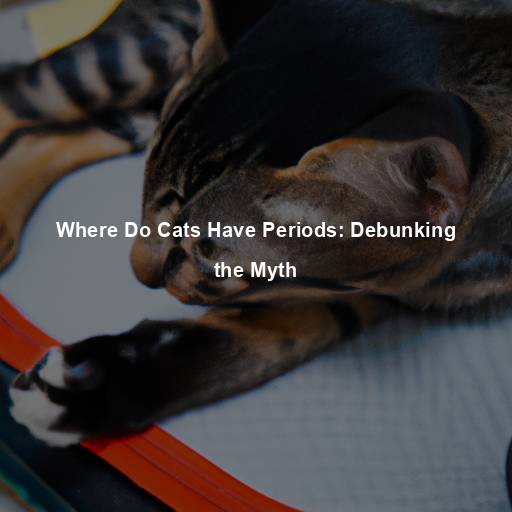Why Do Cats Knead?
Last Updated on October 19, 2023 by Evan
Contents
- 1 Understanding the Quirky Behavior of Kneading in Cats
- 1.1 Unveiling the Mystery Behind Cats’ Kneading Behavior
- 1.2 The Natural Instincts of Kneading
- 1.3 Territory Marking and Scent Communication
- 1.4 Expression of Contentment and Relaxation
- 1.5 Kneading as a Remnant of Nursing Behavior
- 1.6 Marking Comfort Zones and Preparing Sleeping Areas
- 1.7 Stress Relief and Self-Soothing
- 1.8 The Connection Between Kneading and Neutering
- 1.9 Encouraging and Responding to Kneading
- 1.10 Appreciating the Quirks of Our Feline Friends
- 1.11 Ancient Origins in Wild Felids
- 1.12 The Influence of Nurture and Environment
- 1.13 The Role of Comfort and Security
- 1.14 The Physical Benefits of Kneading
- 1.15 The Emotional Significance of Kneading
- 1.16 The Connection Between Kneading and Suckling
- 1.17 Kneading as a Form of Bonding
- 1.18 Individual Variations and Personalities
- 2 Understanding and Embracing Kneading
- 3 FAQs: Why do cats knead?
Understanding the Quirky Behavior of Kneading in Cats
Unveiling the Mystery Behind Cats’ Kneading Behavior
Cats have a repertoire of fascinating behaviors that often leave us puzzled and intrigued. One such behavior is kneading, where cats rhythmically push their paws into surfaces, often accompanied by purring and a blissful expression. But why do our feline friends engage in this peculiar behavior? Let’s delve into the world of cats and explore the various theories behind their kneading behavior.
The Natural Instincts of Kneading
The mysterious ritual of kneading has long captivated the feline world, transcending generations and perplexing even the most well-informed cat enthusiasts. From the tender moments of nursing, when tiny paws explore the contours of their mother’s mammary glands, to the bittersweet nostalgia of adulthood, where cats yearn for the soothing embrace of their early days, this ancient behavior remains an enigma. What drives these curious creatures to repetitively press and release their paws against soft surfaces, as if searching for answers in a world brimming with uncertainty? As we delve deeper into the intricate tapestry of feline psychology, the perplexing allure of kneading gradually unveils its hidden secrets.
Territory Marking and Scent Communication
Have you ever wondered why your furry feline friend loves to knead? Well, it turns out that cats have a secret weapon hidden right beneath their adorable paw pads – scent glands! These glands release pheromones as cats knead on different surfaces, creating a mystical trail of their unique scent that marks their very own territory. This intriguing behavior not only serves as a form of communication among our feline companions, but also allows them to leave their personal signature on objects, asserting their ownership with a touch of paw-filled perplexity.
Expression of Contentment and Relaxation
Have you ever paused to observe the peculiar yet endearing sight of your feline friend gracefully kneading away while emitting a symphony of soothing purrs? This mysterious behavior, intricately woven in the tapestry of their intriguing nature, is said to be accompanied by a plethora of emotions, perhaps most notably a blissful sense of comfort and unwinding. Scientists posit that this rhythmic motion may serve as a self-soothing mechanism, triggering the release of endorphins, those enchanting elixirs of tranquility and euphoria. Therefore, the next time your furry companion graces your lap or a velvety blanket with their tender kneads, rest assured that they are not merely engaging in a routine physical act, but rather thoughtfully crafting an oasis of coziness for themselves, all while expressively conveying their sheer contentment.
Kneading as a Remnant of Nursing Behavior
It is quite intriguing to ponder the peculiar behavior of kittens kneading their mother’s mammary glands during nursing. This instinctive act, believed to have a practical function of stimulating milk flow, continues to bewilder as these feline creatures grow into adulthood. Perhaps, in the depths of their enigmatic minds, kneading serves as a euphoric reminiscence of their tender beginnings, granting them solace and reassurance in a world full of uncertainty.
Marking Comfort Zones and Preparing Sleeping Areas
Cats possess an innate knack for seeking out the epitome of snugness when it comes to snoozing. The mere act of their paws rhythmically kneading upon a chosen surface seems to be their enigmatic means of transforming it into an optimal sanctuary for repose. Through their tender kneading and gentle padding, cats ingeniously fashion a cloud-like haven that beckons them to snuggle in and surrender to a state of serene tranquility. Consequently, when your feline turns your bed or a mound of blankets into their personal sleep haven, rest assured that they are, quite literally, meticulously crafting the ultimate nap-worthy domain.
Stress Relief and Self-Soothing
There’s an intriguing link between human and feline behavior when it comes to stress management. While we may opt for stress balls or fidget spinners, our furry friends have a unique strategy – kneading. Yes, you heard it right, cats knead not only to express contentment but also to alleviate anxiety. So, the next time you see your feline companion kneading away, consider it as their personal stress relief technique, as they rhythmically press their paws to find their calm in the chaos.
The Connection Between Kneading and Neutering
Interestingly, there is anecdotal evidence suggesting that neutered or spayed cats tend to knead more than their intact counterparts. This could be due to hormonal changes that occur after the procedure, altering their behavior. However, more research is needed to fully understand the correlation between kneading and neutering.
Encouraging and Responding to Kneading
Kneading is generally a harmless and natural behavior for cats. However, it’s important to ensure that they have appropriate surfaces to knead on, such as scratching posts or designated blankets. If your cat kneads on furniture or other inappropriate surfaces, redirect their behavior by providing alternatives and rewarding them for using those surfaces instead.
Have you ever wondered what it means when your feline friend decides to knead on you? It’s actually a heartwarming signal of trust and adoration! Now, while some kitties may opt for a gentle kneading session, others might showcase their enthusiasm with a touch of claw action, which can, let’s admit it, be quite perplexing. But fret not, dear cat lovers!
Appreciating the Quirks of Our Feline Friends
Cats, the perpetual enigmas of the animal kingdom, mystify us yet again with their perplexing behavior known as kneading. This mesmerizing ritual defies simple explanation as it encompasses a range of motivations, from revisiting cherished moments of kittenhood to asserting their territorial prowess. Even more intriguing is the notion that this rhythmic motion serves as a therapeutic mechanism, offering a soothing balm for their enigmatic souls. By unraveling the mysteries hidden within their kneading tendencies, we unlock a deeper connection with these captivating creatures that grace our lives.
Have you ever found yourself captivated by the enigmatic behavior of your feline friend as they deftly engage in a mesmerizing kneading ritual? If so, you’re not alone. The origins of this perplexing phenomenon have long intrigued both scientists and cat enthusiasts alike, leaving us with a sense of bewilderment and marvel at the peculiar ways of our beloved pets. As we delve into the intricate tapestry of feline behavior, we uncover a fascinating world where each knead becomes a moment to cherish and cherish the infinite layers of our furry companions’ adorable and mysterious nature.
Ancient Origins in Wild Felids
Discovering the mesmerizing roots of kneading takes us back to the captivating world of wild felids, captivating creatures like lions and tigers. These majestic beasts gracefully partake in a peculiar act known as trampling, where their paws gracefully adorn the earth with rhythmic movements. This intriguing ritual serves a multitude of purposes, including marking their territory and creating sanctuaries of repose. It is hypothesized that the domestic cats we cherish today have inherited their kneading behavior from these wondrous ancestral traditions.
The Influence of Nurture and Environment
While the instinct to knead is deeply ingrained in cats, nurture and environment also play significant roles in shaping their behaviors. Cats that were separated from their mothers at an early age or did not have the opportunity to nurse properly may exhibit less pronounced kneading behaviors. Similarly, cats that were not exposed to appropriate surfaces for kneading during their formative years may not engage in this behavior as frequently.
The Role of Comfort and Security
There is something truly enchanting about the way cats knead, isn’t there? It’s as if they are tapping into a deep well of nostalgia and seeking solace in the memories of their tender days with their mother. With each gentle press of their paws, accompanied by a melodic purr and a delicate nuzzle, they transport themselves back to that sanctuary of warmth and security. It’s as if through this rhythmic motion, they are able to weave a cozy cocoon around themselves, enveloping their surroundings in a tapestry of familiarity and contentment.
The Physical Benefits of Kneading
There is something truly perplexing and fascinating about the way cats engage in their instinctual behavior of kneading. This burst of rhythmic movement, as their paws effortlessly stretch and flex, not only keeps their limbs in tip-top shape but also improves circulation and maintains those oh-so-important muscles. But that’s not all – the pressure applied during this mysterious ritual almost seems like a self-administered massage, offering a soothing and tension-relieving experience that only cats truly understand. It’s a quirky phenomenon that leaves us marveling at the wonders of the feline world.
The Emotional Significance of Kneading
There is something mesmerizing about the rhythmic motion of a cat’s paws as they knead, as if they are unearthing secrets hidden in the fabric of time. It’s a blend of physicality and profound emotion. These feline beings express their innermost state when they embark on this enigmatic journey of kneading – contentment, relaxation, or a desire for your undivided attention. In their own silent yet expressive language, they beckon you to partake in their felicity, welcoming you into the intimate realms of their emotional universe.
The Connection Between Kneading and Suckling
It’s no secret that cats have some interesting quirks, and their kneading behavior is no exception. You may have noticed your furry friend engaging in what seems like a mini massage session on your lap or a soft blanket. But what’s behind this peculiar action? Well, it turns out that kneading is often accompanied by suckling actions, as if cats are transported back to their adorable kitten days.
Kneading as a Form of Bonding
When cats knead on their human companions, it can be seen as a bonding behavior. By kneading, cats release pheromones from their paw pads, marking their scent and creating a connection with their owners. This act of kneading on their favorite humans can be interpreted as a sign of trust, affection, and a desire to strengthen the bond between cat and human.
Individual Variations and Personalities
It’s fascinating to observe the diverse world of feline behavior, particularly when it comes to the enigmatic ritual of kneading. A captivating quirk of some cats, kneading can be a delightful sight or a mysterious absence in others. From fervent kneading aficionados to the occasional practitioners, every cat exemplifies its singular personality through this captivating practice. The mysteries behind their motivations to either engage in rhythmic paw-pushing or abstain from it altogether only add to the allure of our feline friends.
Understanding and Embracing Kneading
For those of us lucky enough to have a furry feline companion in our lives, we often find ourselves pondering the peculiar phenomenon known as “kneading”. Why do our beloved cats insist on rhythmically pawing at our laps, cushions, and even soft blankets with such fervor and determination? Well, dear cat owners, fear not! There is a method to their kneading madness, and by delving into the depths of their instinctual and emotional motives, we can uncover the secrets behind this adorable behavior.
Providing Suitable Surfaces for Kneading
To encourage appropriate kneading behavior, it’s crucial to provide cats with suitable surfaces to knead on. Investing in a sturdy scratching post or providing designated blankets or cushions can redirect their kneading instincts away from furniture or other inappropriate objects. By offering these alternatives, you can create a positive environment for your cat to express their natural behaviors.
Trimming Nails and Using Soft Barriers
If your feline friend’s enthusiastic kneading comes with an unintentional prickly surprise, fret not! Taming those little claws can do wonders. Keep them in check with regular trims, ensuring a purr-fectly safe and scratch-free experience. And for some added peace of mind, lay down a cozy shield, like a snuggly blanket or plush towel, creating a blissful barrier between sensitive skin and those pointy paws.
Observing and Responding to Your Cat’s Needs
When it comes to our feline friends, decoding their mysterious ways can be a captivating yet perplexing endeavor. A glimpse into their world reveals that the way they knead is not just a random act, but rather a complex code trying to communicate their individual desires and sentiments. While some cats may knead with fervor when craving attention or seeking validation, others may engage in this behavior to establish their ownership over their territory. By responding to their kneading with tenderness and nurturing interactions, we not only nurture our bond with them but also offer the emotional solace they crave.
Appreciating the Quirkiness of Cats
There’s something undeniably enchanting about cats, an air of perplexity that surrounds their every movement. It’s in their mesmerizing gaze and their unpredictable quirks that we find ourselves captivated. Take, for instance, the mesmerizing act of kneading, a behavior that both fascinates and perplexes us. By embracing these idiosyncrasies, we unlock a path to building deeper connections with our feline friends, fostering a harmonious coexistence that benefits both humans and cats alike.
FAQs: Why do cats knead?
Why do cats knead?
Cats have a fascinating way of expressing themselves through kneading, a mesmerizing act where they gently massage their paws against anything soft like a cozy blanket or even a human lap. But why do they do it? Well, it’s not just a simple answer as it involves a complex mix of instinctual urges and social dynamics that leave us pondering their curious motivations. So next time you find your feline friend indulging in this bewitching behavior, remember that there’s more to it than meets the eye!
What is the purpose of kneading?
There’s an intriguing theory floating around about why cats knead, and it’s pretty fascinating. The idea is that this behavior actually stems from their early days as kittens, when they would knead their mother’s belly to stimulate milk production. So, even as adult cats, they may continue this kneading routine as a way to reminisce about their nurturing days and find comfort. But here’s where it gets even more intriguing – some experts believe that kneading is also a way for cats to bond with their human companions. Who knew there was so much depth to a simple act of kneading?
Why do cats knead on soft surfaces?
Cats have an innate affinity for kneading on indulgent, yielding sensations, as it evokes a sense of solace and nostalgia for their cherished nap nooks and relaxation retreats. The gentle act of kneading on soft textiles, like cozy blankets or plush pillows, seems to lull them into a state of blissful serenity. By indulging in this rhythmic motion, cats find solace, tranquility, and an unparalleled peace that envelops their beings.
Can kneading indicate happiness?
Yes, kneading can be a sign of contentment and happiness in cats. When a cat is relaxed, feeling safe, or enjoying their environment, they may start to knead. It can signify that they are at ease and feeling secure in their surroundings. However, it is essential to consider other behavioral cues along with kneading to fully understand a cat’s emotional state.
Is kneading a territorial behavior?
When cats knead, it’s not always about asserting their dominance. Surprisingly, this behavior is often driven by their innate desire for comfort and security. Nevertheless, there are occasions when kneading can also be a way for cats to leave their scent and mark their territory. Although less frequent, this territorial kneading serves as a means for felines to assert their presence and lay claim to their space in the most peculiar of ways.
Can kneading be problematic?
Kneading is a fascinating feline behavior that usually poses no issues, but there are times when it can leave cat owners perplexed. Occasionally, cats may employ their sharp claws during kneading sessions, leading to unfortunate scratches and furniture marring. To address this, it is wise to regularly trim the cat’s nails or supply them with designated scratching zones to alleviate any potential damages. However, if the kneading behavior becomes unusually abundant or prolonged, it might hint at underlying anxiety or discomfort, prompting a visit to the veterinarian for a thorough assessment.
How can I encourage or discourage kneading?
When it comes to your furry feline’s adorable yet puzzling kneading habits, catering to their comfort is key. Create a haven of snug blankets and plush textures where they can revel in this quizzical behavior without any worry. Nonetheless, if their kneading ventures start veering towards chaos or destruction, it’s time for some redirection towards a scratching post that has been appointed as their new go-to spot. Shower them with praise and rewards when they embrace this desired surface, while considering the strategic implementation of deterrents to safeguard your cherished belongings from their intriguing antics. Embracing positive reinforcement and unwavering consistency in your training endeavors will surely help unravel the complexities of this adorable quirk.






